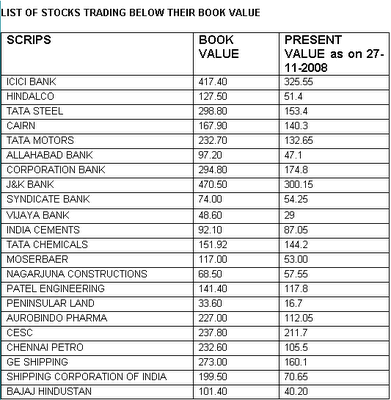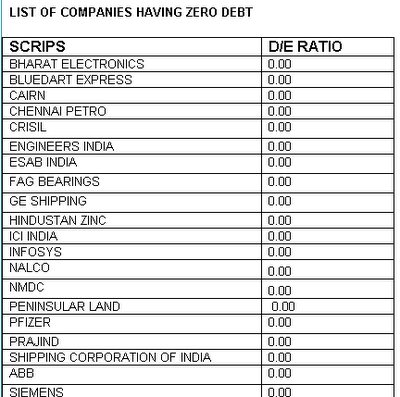How to buy stocks ? Buy stocks with confidence
Current stock market, as we all know, is in an uncertain situation with ups and downs in stocks every week. Every investor may be wondering about how to buy a stock as buying stocks for long term investment has become difficult when there are no clear market trends.
We advise investors to keep the following factors in mind in order to make safe and sensible investments.
Stock trades at cheap brokerage and buying stocks online or online stock trading have made stock trades a very frequent practice for normal investor, they should understnad that stocks mentioned here are for long term investing and will be fruitful if they hold for longer time durations.
1. Low Debt-Equity ratio stocks
This is the ratio shows that how much equity and debt is used by the company to finance its assets. Debt-equity ratio above one shows that the company has resorted to debt for financing its assets rather than equity. If the ratio is lower than one, it means the company has a lesser debt burden. The positives of such companies are that they need only a lesser amount to be kept aside to pay the interests that arise out of loans. The fluctuations in interest rates during high inflationary situations may have little impact on the financials of such companies. So companies that have zero debt should be targeted with a medium to long-term perspective.
CHECKOUT:
Best stocks to buy for 2009 – Stocks to buy now
Top 9 Best stocks to buy for 2009
Value stocks to buy in 2009
2. Stocks trading below their book values
Another factor to be kept in mind while investing in shares is the book value. The book value of a company is the cost of an asset minus accumulated depreciation. In other words it is the total value of the company’s assets that shareholders would theoretically receive if a company is liquidated. So, if a stock is trading below its book value, then it is underpriced, and should therefore be seen as an opportunity to make an investment in that stock.
3. Buying ‘A’ group stocks
An investor with a medium to long-term perspective can, without any hesitation, go for stocks in the ‘A’ group, even if the situation is not very favourable. Once the markets consolidate and pick up, the first stocks to move up will be the ‘A’ group stocks as they form the index. When the index moves up, obviously these stocks will be the movers. One main thing to keep in mind is that, never make your whole investment in a single sector or a stock. Instead, investors should create a diversified portfolio including more than one stock belonging to different sectors.
4. Following the averaging pattern of investment
Investors should follow the averaging pattern of investment when the markets are volatile and not giving any trends. This will put the investors in a better position. The investor has to enter the market at three or four different times which will help the investor to reduce the per share price of his holdings.
E.g. if an investor is desirous of making an investment of Rs 40000, he should invest the money at three or four different times with an investment of Rs 10000 each. When the stock which the investor wants to invest in is trading at Rs 100, he can make his first entry by investing Rs 10000 and purchasing 100 shares of the stock. When the share price comes down to Rs 80, he can make his second entry by investing Rs 10000 and purchasing 125 shares. When the share falls to Rs 70 and then Rs 60, the investor can make his third and fourth entries by investing Rs 10000 each, and purchase 143 and 167 shares, respectively. When the market moves up from lows, the average rate of the stock in the investor’s portfolio will be Rs 74.7 which will be the investor’s BEP.
The following table shows the stocks that are trading below their book value and with zero debt. Investors also can go for stocks in the ‘A’ group segment which are/are not given in the table given below. Investment should be made in these stocks in the above said averaging pattern.
Second Image
Source: Geojit Securtiy research house
Tags: 52 week high, 52 week lows, account, accumulate, analysis, analysts, analysts poll, announcement, arbitrage, balance sheet, bear, bearish, Bombay stock exchange, bonus, book building, book closure, book running lead manager, broker research reports, brokers corner, bse, bull, bullish, buy, buy signals, chart, chat, cnbc India, cnbci, company, company information, company results, corporate, crash, crossovers, derivative, directors, dividend, double tops, equities, equity, expert, expert speaks, fibonacci, fibonacci retracementmarket analysis, fii, finance, financial, fund manager, futures and options, graph, half yearly results, HOLD, hot stocks in 2009, index, index composition, india, industry, industry classification, infosys, initial public offer, internet trading, investment, Investment Idea in 2009, IPO, ipo analysis, IPO FAQs, ipo finance, ipo grievances, ipo rating, IPOs, issue close, issue open, issue price, lead manager, learn stock trading, listed issues, listing, live market map, MACD, map, market, market statistics, merchant banker, mf ipos, mf issues, most active, moving average analysis, mutual fund ipos, national stock exchange, new issues, news, nifty, nse, oversubscribed, performance, Pharma, pivot point, pre-market analysis, price, price band, profit and loss, promotor, PSUs, public offer, quarterly results, quotes, rally, ratios, recommendation, record date, red herring prospectus, registrar, reliance, research, resistance, rights, run, satyam, scrip, scrips, sectors, sell, sell signals, sensex, share, share price ticker, shares, slump, split, stats, stock, stock analysis, stock breakdown, stock breakout, stock exchange, stock indicators, stock market, stock market analysis, stock market commentary, stock prediction, stock resistance level, stock support level, stock tips, stock trading, stock volume, stocks, stop loss, subscription, Support, technical, technical resistance, technical support, technology, Top 2009 stocks, top gainers, top losers, trading, trading systems, trading tips, triple tops, udayans stocks, upcoming issues, valuation, value, views, volume, wipro
Similar Posts:
Latest Query
- by Sam
Search Our Archives
Research Desk
- Stocks Trading above their 50 day moving average - DMA In Stock Research
- Download free Ebooks based on Technical Analysis In Personal Training
- TOP 100 Stocks with the Highest P/E as on July 14th, 2013 In Stock Research
- TOP 100 Stocks with the Lowest P/E as on July 14th, 2013 In Stock Research
- Charting Pathsala - Your guide to Techincals In Technical Analysis







